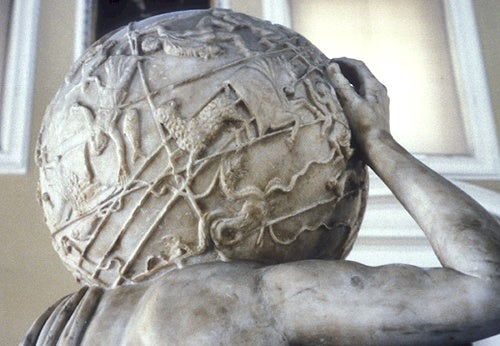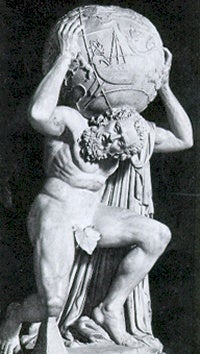The ancient Greek astronomer Hipparchus discovered the precession of the equinoxes, invented the stellar magnitude scale, discovered a nova, and made accurate planetary observations. He also compiled the world’s first star catalog, in 129 b.c. But the catalog vanished in antiquity, and Hipparchus’s only surviving work is his Commentary on the Phaenomena of Aratus and Eudoxus, which describes the celestial constellation figures in detail.
The catalog may be lost, says Bradley Schaefer of Louisiana State University, but a famous statue preserves a pictorial record of the sky as Hipparchus cataloged it. The statue, a Roman copy from around a.d. 150 of a Greek original, is known as the Farnese Atlas. Located in the National Archaeological Museum in Naples, Italy, it depicts the mythological figure of Atlas kneeling as he holds a celestial globe on his shoulders.
Precession — the slow shift of Earth’s axis that Hipparchus himself discovered — provides a way to date the globe. Schaefer says the figures’ positions relative to the meridians and the equator point to the year 125 b.c., with an error of 55 years either way. This date closely matches that of Hipparchus’s catalog.
Importantly, it does not match the dates of other ancient sky descriptions, including both Aratus’s and Eudoxus’s Phaenomena and the sky catalog published in the Almagest by Claudius Ptolemy. The two Phaenomena date from 275 and 366 b.c., respectively, while the Almagest dates from about a.d. 130. In each, some figures, or their locations, do not fit the Farnese globe. To Schaefer, this indicates the sky positions in those works come from a different time or source than Hipparchus.
“I think the original Greek sculptor had one of Hipparchus’s working star globes,” says Schaefer, who notes that Hipparchus is known to have made several sky globes. The generally high quality of the mapping, detectable even after transmission through the Roman copy, suggests the original sculptor took great care in the carving — and had an accurate sky globe to work from.
Says Schaefer, “It’s fascinating to think we have recovered perhaps the most famous piece of ancient wisdom.”











